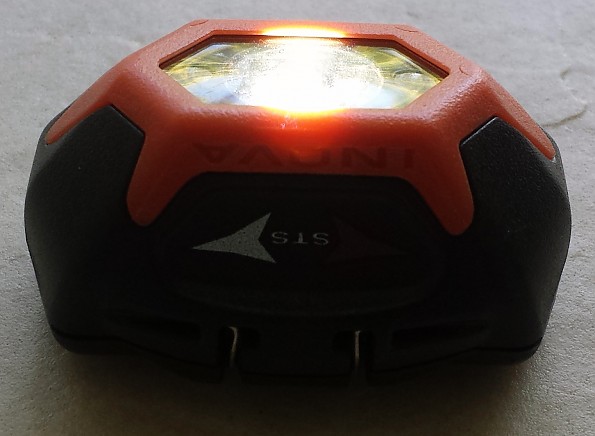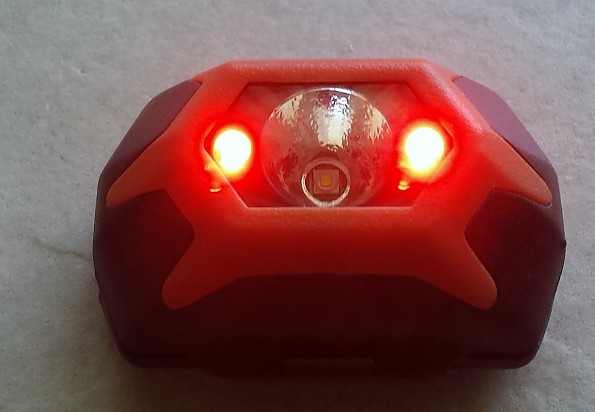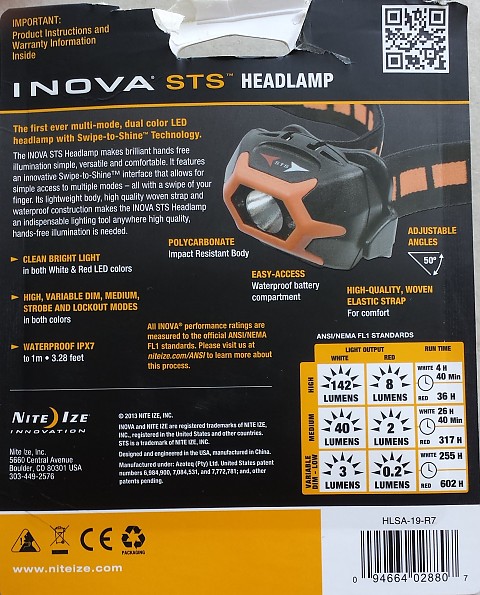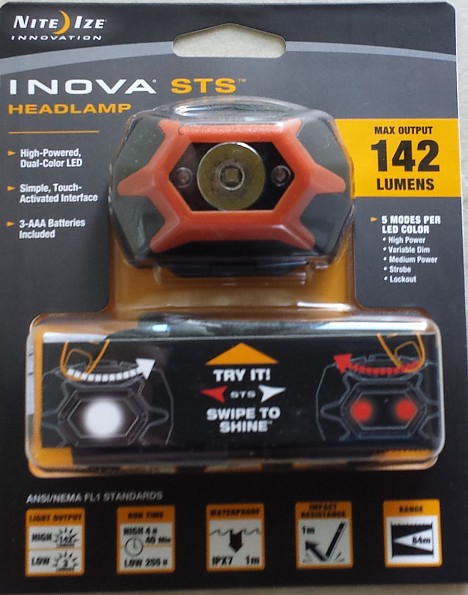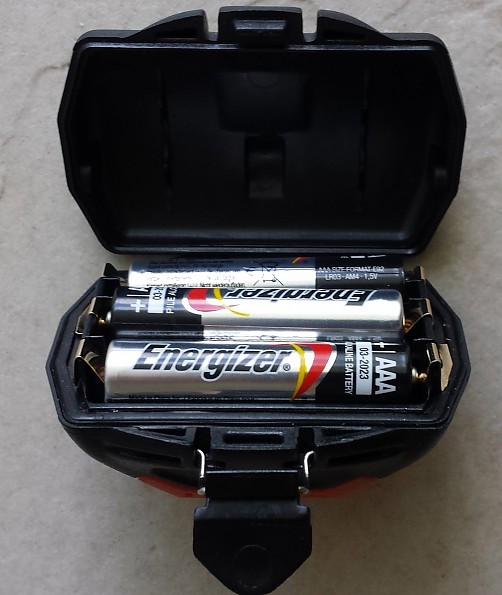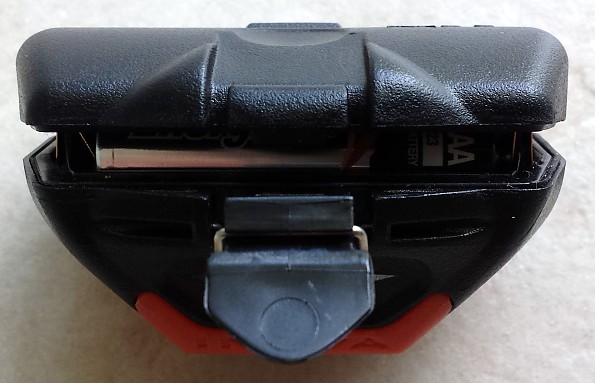Nite Ize Inova STS

The Inova STS is a feature-rich, uber-bright headlamp that takes a decent stab at innovating the classical on/off switch. With the popularity of gesture-driven devices, it follows that a company would produce a swipe/touch activated interface in a headlamp.
For the most part, I found this interface to be intuitive and reliable, though I definitely encountered some trying times in humid conditions. For use in damp situations, such as in caves or on the water, I might recommend this as a pass.
Otherwise, the Inova STS is a well-designed, durable, incredibly adjustable and bright headlamp that would be useful in a variety of applications.
Pros
- Very bright high beam at 142 lumens
- Duel white and red LED light, both with high, medium, variable and strobe modes
- Variable dim allows for precise setting of intensity down to 3 lumens
- Lockout setting for storage in a pack
- Waterproof, compact, durable, reasonably lightweight design
- Uses 3 AAA batteries (easy to find replacements or use rechargeable’s)
- Intuitive swipe/press-and-hold interface easily (usually!) cycles through all the functions
- Priced very affordably given large feature set
Cons
- Headband is on the large side (upside is that it adjusts to fit all the way around my torso!)
- Swipe function can sometimes be erratic, especially in the humidity
- If not used regularly, it might be hard to recall how to enable some functions (lockout mode)
- No low-battery indicator
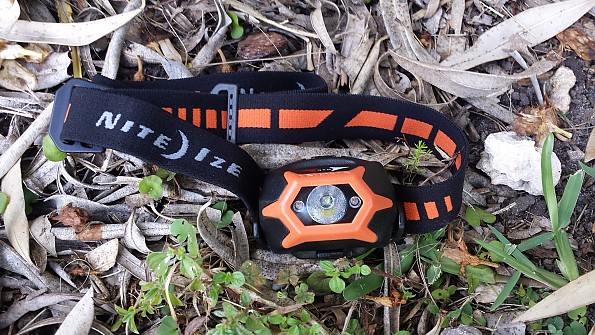
Inova STS Specs: In case you're wondering, the 'STS' is short for "Swipe To Shine"
Limited lifetime warranty, 3-year warranty on LED bulbs and switch.
Waterproof (IPX7) to 1 meter
Total Weight (3 AAA alkaline batteries & headband/mount): 3.4 oz. / 96 g.
Total Weight (3 lightweight AAA energizer ultimate lithium batteries & headband/mount): 3 oz. / 84 g.
Weight w/out headband/mount: 2.3 oz. / 64 g.
Stripped weight (no batteries or headband/mount): 1 oz. / 30 g.
Headband/mount weight: 1.1 oz. / 32 g.
Dimensions: roughly 2 x 2.5 inches
Headband width: 1 inch
Brightness and Burn Time (reported):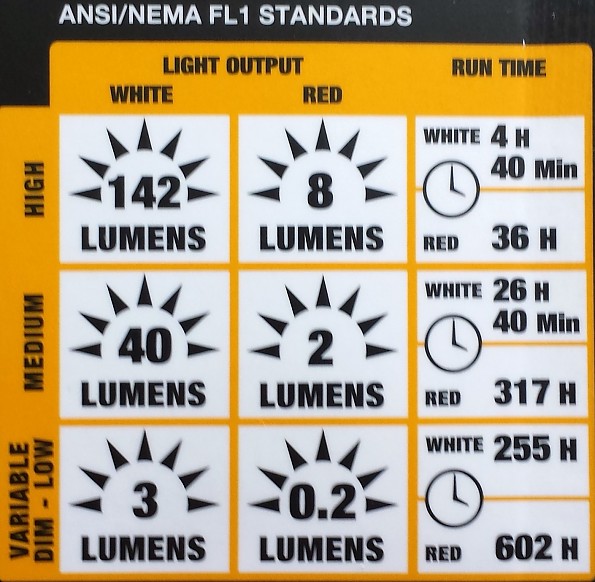
Operation/Functions: Red and white modes all follow the same pattern by swiping in the direction of the corresponding arrow. Combination swipes must be within 2 seconds of one another. After a 3 second delay, 1 swipe in either direction will turn the lamp off.
1 swipe: high
2 swipes: medium
3 swipes: flashing
Variable dim mode: 1 swipe followed by a press-and-hold with one finger will enter this mode, allowing for customized intensity down to 3 lumens. The light will dim to this level, blink once, and then begin to increase again. Releasing the finger at any time during this cycle will set the intensity.
(this is a video of the white and red lights cycling through high, medium, flashing, and variable intensity modes)
Lockout Mode: With 2 fingers, press-and-hold until the Red LED blinks once, then swipe once in either direction. The Red LED will blink rapidly for 1 second to indicate the lamp is in the Lockout Mode and subsequently for all swipes afterwards.
To disengage the Lockout, press-and-hold with 2 fingers until the White LED blinks once, then swipe once in either direction…the White or Red light will turn on depending on the direction of this swipe. The Lockout Mode can also be disengaged by removing and reinserting the batteries-REBOOT!
About my uses and a fair (or unfair?) comparison…I don’t crawl through caves or commence early morning alpine ascents like some of the more intrepid reviewers here (Bill S and G0Ose:); thus I don’t have any experience with the more robust headlamp-category (having battery packs and such). I also made the switch to LED lamps just as they came into popularity 15-ish years ago, so my exposure to the hassles of burned-out incandescent/halogen bulbs and battery-sucking head anchors is limited.
But I have spent extended periods standing night watches on ships, during which my compact but feature-rich Petzl Zipka Plus has been an indispensable tool. Particularly, I value the ease of turning it on and off, given that I frequently have to read something/view an instrument and then return to the darkness. Likewise, having dual red and white LED’s is an absolute must for preserving my night vision.
Further, I need a lamp that returns immediately to red when switching between on and off. Having to cycle through white settings to get to the red would be counter to the reason for needing a red light in the first place.
(a size/feature comparison with my other Petzl headlamps)
So I will concede that I judge other headlamps based on the standards that Petzl has set, especially in their ultra-compact Zipka and eLite series. Over the years, I have tried a few other brands such a Princeton Tec, but none stood up to my demands like the Petzls.
In having painted the picture here, the performance and feature set of the Inova STS place it high amongst my preferred Petzl lamps. The red/white bifurcated swipe function make on/off and intensity cycling pretty smooth…in ideal or climate controlled-settings that is. Because I found it to be a bit erratic in high humidity, I would hesitate to take it kayaking/skiing/caving, where gloves and/or the wet might make the swipe function difficult (much more on this to follow).
Beam & Brightness: I was very satisfied with the brightness, span, and focus of the beam. This is the highest intensity headlamp that I have used yet, so of course there was a noticeable difference when compared to the rest of my collection. The reflective tunnel that the single white LED is housed in also seems to boost the intensity, similar to the maxbright LED of the Printon Tec Remix. The lamp casts a very eye-appeasing white to yellow tone, which is impressive for an LED. I’ve found that others appear bluish and are harsher on the eyes. The beam is also very even throughout, with a natural graduation to the outer edges (no harsh concentrated spots in the middle).
Employing the variable intensity function, I was able to do everything from hike trails at night to read inside my tent. When used appropriately, this feature also greatly improves the longevity of your batteries. I do wish that the Inova STS had a recall function to be able to return to the previously set intensity after switching off and back on again.
I've already mentioned my needs for having a red light mode when standing watch on a ship. I wouldn't buy a headlamp without this feature, so I was very pleased that the Inova STS included it. The Red mode is also very useful and comfortable for various other activities, especially when eating your dinner in a campfire circle with friends. Nobody enjoys having a white headlamp beam bouncing around in their faces. Plus, the warning label about not shining the light in someone’s eyes really should be headed…at full power it’s rather blinding.
Range: At high intensity, range is stated to be 84 meters. I didn’t measure this distance in the field but I think it’s sufficient to say that 142 lumens will go a long way, long enough for most activities. I’m going to take it offshore a known distance (using my GPS) and try to spot the shoreline to better test this in the near future.
Burn time and temperature: I tested the continued use of the high beam (142 lumens), measuring dim and burn-out time. I used new Eneloop NIMH rechargeable batteries, rated for 750 mAh, for this test. I repeated the test twice. Both times I found that the light began to dim between 2.5 and 3 hours. By 4 hours the light was pretty diminished but still could assist in walking in the dark and doing simple tasks. After 7 hours the light was still going, probably around 10 lumens, so I called this sufficient and turned it off.
The product literature claims a burn time of 4 hour 40 minutes at 142 lumens…I don’t know if this means that the light will remain at this intensity for that amount of time or only that it won’t burn out completely. In my testing, intensity did decrease in less than the stated time but the light continued at a lower intensity well past this time. Thus I would say that the burn efficiency is pretty good, especially at lower lumens.
At the high mode, the lamp temp. becomes warm to the touch but never exceeds a temperature unsafe or even uncomfortable to touch... aren’t LED’s great?
Ease of use: This all boils down to the new swipe interface, which can be fantastic or very irritating, depending on the conditions. In un-boxing the lamp, I went through the instructions and practiced all the swipe methods in the comfort of my living room. I was initially very impressed by the re-activeness and accuracy of the swipe pad. All modes were consistent and easy to achieve, including the lockout mode.
Then I went outdoors, or more precisely, into the South Florida swamps. During my first night out, I started experiencing inconsistencies. I would swipe to turn the lamp on and nothing would happen. Or I would swipe to turn it off and again, nothing. Making multiple swipes in quick succession only seemed to confuse it. Through practice, I found that if at first I didn’t succeed, it was best to wait a few seconds to try again. In utilizing more patient and deliberate swipes, I got better results.
I would note here that at no time did the light ever completely fail to turn on. At most it would take me a few attempts and some patience. But when out in the wilderness, this can be frustrating at the least and perhaps even a little dangerous at the worst.
(A bad tent-selfie)
On further trips, I noticed that the performance of the swipe interface directly related to the relative humidity. In the early evening everything would work smoothly but as the night progressed and the temperatures dropped, so did the swipe performance. Perhaps this is not all that surprising, given that the instructions do explicitly state that the swipe pad and fingers must be dry for the lamp to function properly.
The unit is well sealed, thus it’s not a matter of water working its way into the pad but rather an issue of connectivity or something. Water droplets, even in the form of humidity, appear to cause interference. Yet the lamp returns to perfect functionality when dried or the humidity is reduced; thus it’s not a cumulatively debilitating effect.
The other function I found a bit confusing, or rather contrary to the instructions, is the lockout mode. For some reason I got it stuck in my head that it takes only one finger pressed on the pad to trigger/deactivate this mode. And in trying this, I found out that the lockout can indeed be set and deactivated this way as well! So I’m a little unclear why the instructions call for two fingers…perhaps this simply is to not confuse things in setting the variable dim, which also requires a one-finger press.
Comfort/weight:
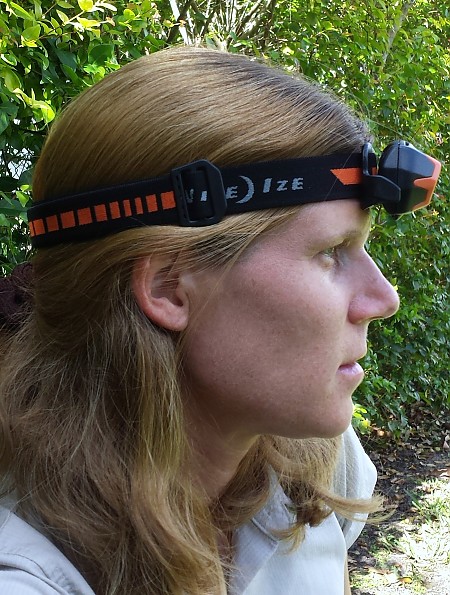
The Inova STS is a bit bulky and heavier when compared to most of my other headlamps…which is expected given that I have selected others precisely for their compact and lightweight designs.

Much of this weight comes from the overly-generous headband. While it was very comfortable to wear around my head, it also adjusted to fit all the way around my torso!

I find this to be a tad much. I’d rather it come with a slightly slimmer band and smaller adjustment range to cut down on some of the weight/bulk. I think that the lamp portion itself is well-designed and pretty compact. It is only slightly larger than my Zipka Plus and with a much higher lumen rating, this can easily be forgiven.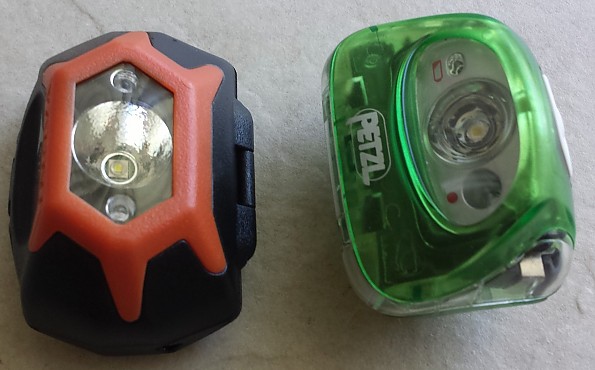
Finally, the removable bracket functions well in fine increment stops and provides for a large adjustment angle range of 50°. This is better that the Zipka-plus in that its retractable headband design doesn't allow for angle adjustments.
Construction and durability: The Inova STS scores high points in this category due to its sleek, impact-resistant polycarbonate body. I appreciate the ‘cleanliness’ of the design in that there are no sharp edges, appendages, or buttons, all of which can cause failure points where water-resistance and use/abuse is concerned. The wire cam latch that secures the casing is THE BEST design I have seen yet in a headlamp, giving high confidence in the waterproof rating. In this, the company actually seems to have taken notes from underwater camera housing design.
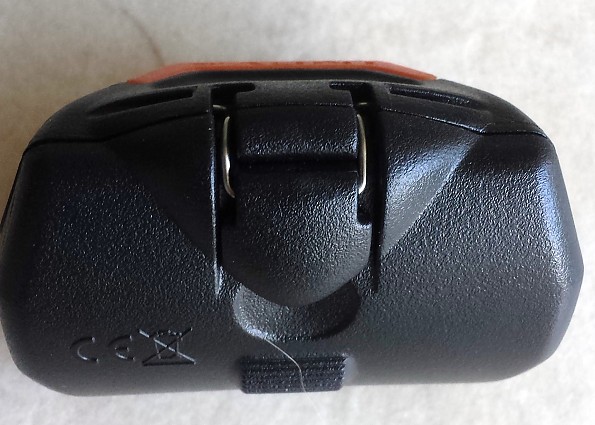

I did run the headlamp under a water stream and found no problems with leakage. It's really too bad about the swipe interface being affected by water, because the durable construction of the rest of the lamp make it ideal for wet applications.
I guess I can envision various activities that involve only intermittent periods of wetness, allowing for the beam to be set and then left alone for the duration. Perhaps if one just carries a dry cloth along to wipe down the surface, this isn’t too big of a deal. Obviously it’s not meant to function underwater as a dive light.
Opening the casing and replacing batteries is very easy, even in the field. There are other headlamp designs that I have really struggled to get open and yet easily failed to keep water out. Again, the Inova STS’s cam latch provides an excellent interface by which to secure and un-secure the case. The tab feels study, yet is reasonably easy to lift and undo, even with bare fingers. Also, the design leaves no uncertainty as to whether it's closed properly or not. Bravo in all of this.
As to the lifespan of the swipe pad, well, this is anyone’s guess given that it’s such new technology. Late-adopters may have cause for a wait-and-see approach; though the company does warrant this for a period of 3 years. I think given the affordable price-point and rich feature set, it’s worth the risk.
Room for Improvement (in-a-perfect-world):
- Offer a range of headband sizes, or better yet, 'imitate' other design in having a retractable cord (sorry Petzl if I'm suggesting a copyright infringement, I just love it so much!:).
- Have a setting in which the variable dim can be recalled, in other words, I’d like to be able to set the intensity, turn the lamp off, and turn it back on at the same intensity.
- Include a low-battery indicator.
- Make the swipe function more resilient to humid conditions. I believe with more field testing and feedback from users, most of these bugs can be worked out…we’ve already seen huge improvements in similar touch-activated devices. This will greatly improve the range of activities and conditions that the headlamp can be used for.
All in all, it’s a very decent first attempt! Aside from the humidity issues, the Inova STS is a solid and incredibly useful headlamp. I think with some refinement, the swipe feature will prove its place amongst the better headlamps.
Testing Conditions: I used the Inova STS over a period of 2 ½ months in the field for work, backcountry excursions, and around the house. I carried it on three overnight backpacking trips, used it for reading, and stood a few night watches on the ship. I even tried my hand at herping in a cypress swamp, where I easily spotted a leopard frog…catching it was another story but I can’t blame the light on my slow reflexes. I subjected the headlamp to light rain and high humidity in many circumstances, as noted above.
If given the opportunity, I will continue to test it in drier outdoor environments and report back on my findings.
Source: received for testing via the Trailspace Review Corps
(Sample provided by Nite Ize for testing and review)


